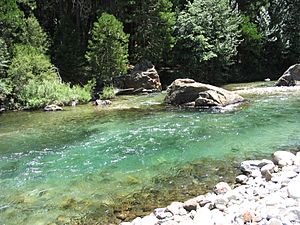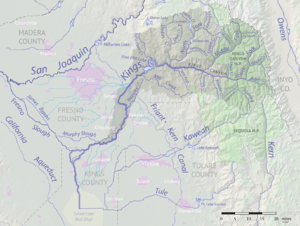Middle Fork Kings River facts for kids
Quick facts for kids Middle Fork Kings River |
|
|---|---|

Middle Fork at Tehipite Valley
|
|

Map of the Kings River watershed, including the Middle Fork
|
|
| Country | United States |
| State | California |
| Physical characteristics | |
| Main source | Sierra Nevada Kings Canyon National Park 11,971 ft (3,649 m) 37°06′17″N 118°39′45″W / 37.10472°N 118.66250°W |
| River mouth | Kings River Monarch Wilderness 2,257 ft (688 m) 36°50′18″N 118°52′30″W / 36.83833°N 118.87500°W |
| Length | 37.2 mi (59.9 km) |
| Basin features | |
| Basin size | 318 sq mi (820 km2) |
| Tributaries |
|
| Type: | Wild |
| Designated: | November 3, 1987 |
The Middle Fork Kings River is a 37.2-mile (59.9 km) long river in California. It is a major branch of the Kings River. This river flows through Kings Canyon National Park in the southern Sierra Nevada mountains.
The Middle Fork Kings River drains a large area of 318 square miles (820 km2). Most of this area is wilderness. This means it is a natural area with no dams or paved roads. The entire river is a National Wild and Scenic River. This protects its natural beauty and wildlife.
Contents
Where Does the Middle Fork Kings River Start?
The Middle Fork Kings River begins high up in the Sierra Nevada mountains. Its source is Helen Lake, near Muir Pass, inside Kings Canyon National Park. The river starts at a very high elevation of 11,971 feet (3,649 m) above sea level.
The River's Journey Downstream
From Helen Lake, the river flows quickly down Le Conte Canyon. It then turns south at a place called Big Pete Meadow. Along its path, it passes the Le Conte Ranger Station. It also gets water from smaller streams like Dusy Creek and Palisade Creek.
Waterfalls and Valleys Along the Way
As the river continues south, it enters a narrow canyon. Here, it drops over a beautiful waterfall known as Devil's Washbowl. It then receives Cartridge Creek. After this, the river flows through Simpson Meadow. This is a wide, high-altitude valley about 6,000-foot (1,800 m) high. Goddard Creek joins the Middle Fork here.
Below Simpson Meadow, the river turns southwest. It flows along the bottom of the Slide Bluffs. Many small streams add to its flow.
Tehipite Valley: A Special Place
The river then reaches the amazing glacial canyon of Tehipite Valley. This is one of the most remote parts of the park. Tehipite Dome is a huge granite rock that rises 3,500 feet (1,100 m) above the river. It is the biggest granite dome in the Sierra Nevada.
In this canyon, you might see rattlesnakes, especially from Simpson Meadow down to where it meets the South Fork. Blue Canyon Creek and Crown Creek flow down the north wall of the valley. They form waterfalls before joining the Middle Fork.
The River's End Point
Further downstream, the Middle Fork flows through Little Tehipite Valley. It then enters a very rugged canyon in the Monarch Wilderness. This canyon is about 8,000-foot (2,400 m) deep and has no trails. It is just outside the western boundary of the park.
Finally, the Middle Fork Kings River joins with the South Fork Kings River. Together, they form the main Kings River. This meeting point is about 50 miles (80 km) upstream from Pine Flat Lake.

